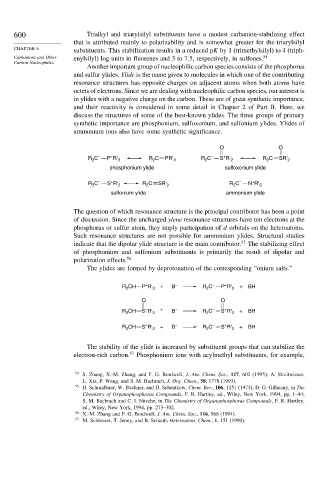Page 618 - Advanced Organic Chemistry Part A - Structure and Mechanisms, 5th ed (2007) - Carey _ Sundberg
P. 618
600 Trialkyl and triarylsilyl substituents have a modest carbanion-stabilizing effect
that is attributed mainly to polarizability and is somewhat greater for the triarylsilyl
CHAPTER 6
substituents. This stabilization results in a reduced pK by 1 (trimethylsilyl) to 4 (triph-
Carbanions and Other enylsilyl) log units in fluorenes and 3 to 7.5, respectively, in sulfones. 54
Carbon Nucleophiles
Another important group of nucleophilic carbon species consists of the phosphorus
and sulfur ylides. Ylide is the name given to molecules in which one of the contributing
resonance structures has opposite charges on adjacent atoms when both atoms have
octets of electrons. Since we are dealing with nucleophilic carbon species, our interest is
in ylides with a negative charge on the carbon. These are of great synthetic importance,
and their reactivity is considered in some detail in Chapter 2 of Part B. Here, we
discuss the structures of some of the best-known ylides. The three groups of primary
synthetic importance are phosphonium, sulfoxonium, and sulfonium ylides. Ylides of
ammonium ions also have some synthetic significance.
O O
+
+
R C – P R' 3 R C PR' 3 R C – S R' 2 R C SR' 2
2
2
2
2
phosphonium ylide sulfoxonium ylide
+
+
R C – S R' 2 R C SR' 2 R 2 C – N R' 3
2
2
sulfonium ylide ammonium ylide
The question of which resonance structure is the principal contributor has been a point
of discussion. Since the uncharged ylene resonance structures have ten electrons at the
phosphorus or sulfur atom, they imply participation of d orbitals on the heteroatoms.
Such resonance structures are not possible for ammonium ylides. Structural studies
55
indicate that the dipolar ylide structure is the main contributor. The stabilizing effect
of phosphonium and sulfonium substituents is primarily the result of dipolar and
polarization effects. 56
The ylides are formed by deprotonation of the corresponding “onium salts.”
+
+
R CH P R' 3 + B – R C – P R' 3 + BH
2
2
O O
+
+
R CH S R' 2 + B – R C – S R' 2 + BH
2
2
+
+
R CH S R' 2 + B – R C – S R' 2 + BH
2
2
The stability of the ylide is increased by substituent groups that can stabilize the
electron-rich carbon. 57 Phosphonium ions with acylmethyl substituents, for example,
54
S. Zhang, X.-M. Zhang, and F. G. Bordwell, J. Am. Chem. Soc., 117, 602 (1995); A. Streitwieser,
L. Xie, P. Wang, and S. M. Bachrach, J. Org. Chem., 58, 1778 (1993).
55 H. Schmidbaur, W. Buchner, and D. Scheutzow, Chem. Ber., 106, 1251 (1973); D. G. Gilheany, in The
Chemistry of Organophosphorus Compounds, F. R. Hartley, ed., Wiley, New York, 1994, pp. 1–44;
S. M. Bachrach and C. I. Nitsche, in The Chemistry of Organophosphorus Compounds, F. R. Hartley,
ed., Wiley, New York, 1994, pp. 273–302.
56 X.-M. Zhang and F. G. Bordwell, J. Am. Chem. Soc., 116, 968 (1994).
57
M. Schlosser, T. Jenny, and B. Schaub, Heteroatom. Chem., 1, 151 (1990).

